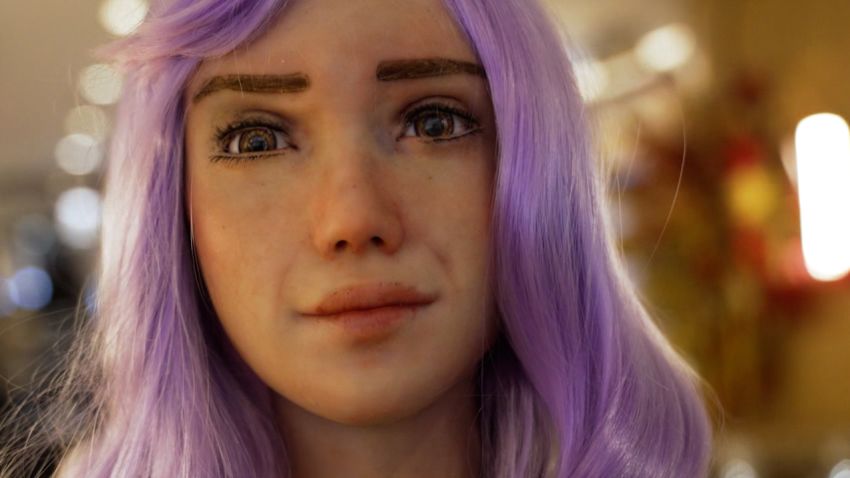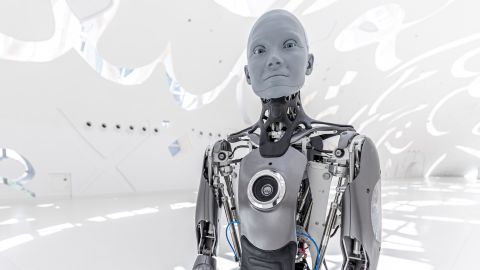CNN
—
Artificial intelligence (AI) has become an integral part of our daily lives, found in everything from social media algorithms to e-commerce and browsing, but not everyone is comfortable with the idea. The key to winning over a skeptical audience might be a family of robot “sisters.”
Sophia, Grace and Desdemona are humanoid robots, each programmed with sophisticated AI. The eldest of the three, Sophia, was first activated in 2016 and caught the eye, mainly for her looks. While most artificial intelligences operate quietly out of sight, powering things like software and smartphones, Sophia is designed to look like a young woman and has earned celebrity status as the face of AI.
In 2017, Sophia was named the first United Nations Development Program Innovation Champion – the first non-human to receive a UN title. In the same year, she obtained Saudi citizenship.
She has since been joined by two siblings, the three robots designed by David Hanson, founder of Hanson Robotics. However, their AI “brains” were designed by Ben Goertzel, the company’s former chief scientist and now CEO of blockchain-based AI company SingularityNET.
“AI mostly exists behind the scenes, in the form of algorithms performing various kinds of pattern recognition and cognition that are difficult for people to understand,” Goertzel told CNN. “The purpose of these robots was to be an interface with the AI world and the human world.”
“The face is one of the main ways humans express their emotions and connect with each other,” he adds. “If you have an AI that you can look into your eyes and it smiles at you, that gives us a subjective sense of connection.”
This feeling of connection could make these humanoid robots extremely useful in certain contexts. Goertzel and his team tested Grace to support older people in the early stages of degenerative brain diseases, such as dementia.
Goertzel says that through these pilots they have seen a “profound and uplifting effect on some very lonely people.” Dementia can cause problems with short-term memory, and he thinks robots could be well-suited to handling the repetitive demands of sufferers.
“If you’re dealing with someone who’s in the middle stage of dementia, they’re just asking the same thing over and over again,” Goertzel says. “It’s the same day after day. The robot will never get tired of it.

Are we already living in a robotic future?
01:58
– Source: CNN
Sophia’s other sister, Desdemona, demonstrates a very different application for this type of technology. She is a member of Goertzel’s experimental band, Jam Galaxy. Goertzel plays the keyboard, while the robot improvises spoken poetry in response to the musical and cultural references that Goertzel feeds into his programming.
Goertzel postulates that robots could also be used for education and in the service sector.
Earlier this year, the Dubai Museum of the Future featured an artificially intelligent guide robot, Ameca, in its “Tomorrow Today” exhibit.
The robot, built by British robotics company Engineered Arts, can answer simple questions from visitors about the museum. His facial expressions and physical responses are almost unnervingly realistic.

“This type of technology has developed in ways that no one could imagine,” says Majed Al Mansoori, deputy executive director of the museum.
“Ameca’s goal is to advocate, to showcase technology… We’ve had people try to ask it really tough questions – visitors are trying to show how humans are smarter than AI. ”
Al Mansoori thinks AI-powered robots could find uses in the tourism and airline industries, “and particularly as guides in places that require orientation, for example hospitals, universities, shopping centers”.
As artificial intelligence has come to subtly permeate our daily lives, research has shown that many people worry about its implications for privacy, job losses and human relationships.
Researchers say AI-based algorithms that are used to provide recommendations on social media can create an “echo chamber” that reinforces people’s opinions and polarizes society. With the technology used to create sophisticated deepfake videos, others have warned of the potential for malicious misinformation.
Giving people the ability to interact with relatable robots could help humanize AI and help improve its image.
“With the humanoid robots we’re seeing developing now, voice, expressions, smiles and gestures, it’s all designed to make you feel more comfortable interacting with technology,” says Al Mansoori.
“There is a growing need for human connection as technology advances. This is one of the reasons people respond so well to humanoid robots.
